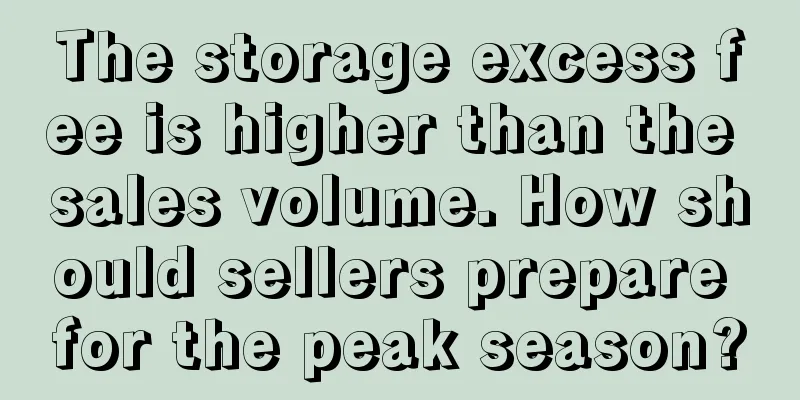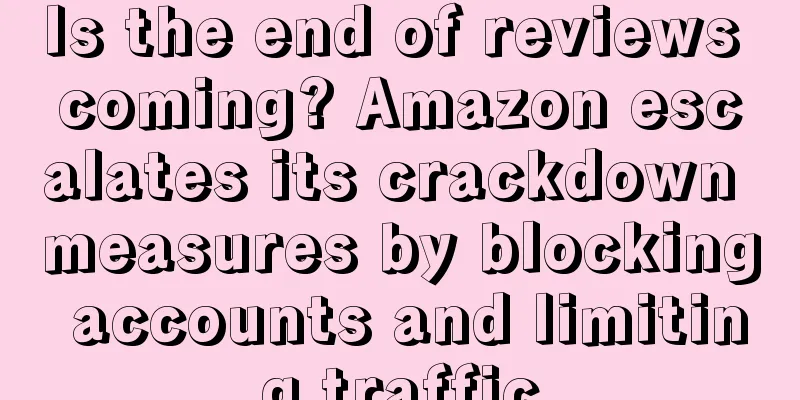The storage excess fee is higher than the sales volume. How should sellers prepare for the peak season?

|
Last month, Amazon announced that it would impose storage restrictions on sellers with an IPI score below 500 in preparation for the peak season. Many sellers have tried their best to improve their IPI scores, such as removing inventory and increasing promotions, but the results have been unsatisfactory.
On August 10, Amazon’s IPI assessment ended. Many sellers with IPI scores below 500 received emails from Amazon regarding excess inventory storage fees, but the high amount of the fees surprised the sellers.
Yesterday, many sellers received an email about Amazon's inventory storage overage fee. The email shows that because the seller's inventory performance index IPI score was below 500 four weeks ago and is still below 500 now, we will adjust your storage capacity limit for standard size, large pieces, clothing and footwear storage types. In addition, all products currently have replenishment quantity limits. Please note that depending on the storage type, any inventory usage that exceeds the storage capacity limit is subject to an inventory storage overage fee of $10.00 per cubic foot.
▲ The picture comes from Zhiwubuyan In the seller group, sellers who received the email posted screenshots one after another. Some sellers’ inventory storage excess fees reached $400, some exceeded $1000, and some even exceeded $6000 . Many sellers joked: Boss, the storage fee is more than what I earn in a month.
In the email, the excess storage fee is just a few numbers, but for sellers, it means a considerable cost, and it is even more of a burden for small and medium-sized sellers with mediocre performance.
Seller: After seeing this shocking storage fee and then looking at the empty order list in the backend, I sang a song "Liang Liang" for myself.
▲ The picture comes from the seller communication group Although Amazon has not yet announced the specific date of Prime Day, the application guide for Prime Day activities on relevant sites has been launched, which means that Amazon's peak season is coming. However, sellers are now facing dual restrictions on shipping and warehousing. Can they still replenish inventory to prepare for the peak season?
Currently, most sellers have a negative attitude towards Amazon’s restrictions on shipments and IPI assessment policies, and are confused about their preparations for this year’s peak season.
Some sellers complained: Amazon's IPI assessment now requires a score of 500 to pass, but Amazon's warehouses either refuse to ship or are overwhelmed, causing sellers to be out of stock, so the IPI is naturally low. Some sellers also said that now Amazon will cancel orders if they remove them!
▲ The picture comes from Zhiwubuyan Some sellers actively try to improve their IPI scores, but it is difficult to meet the standards regardless of whether their sales volume is high or low, or whether they have sufficient inventory.
At present, the epidemic situation abroad is still tense. The unstable logistics timeliness and the limitation of warehouse space make it difficult for sellers. Now they will also face high excess storage fees. Sellers can be said to be struggling to survive in the cracks.
At the same time, by August 15, if the seller has unsaleable inventory in the inventory for more than 365 days, Amazon will charge additional long-term storage fees ($6.9/cubic foot or $0.15/unit, whichever is higher).
The current situation of sellers is that the number of new products shipped is limited, warehouse space is tight, and storage fees are high. Many sellers lament that they lose money on every order they place. Is it still worth doing business with Amazon?
Although the situation facing sellers now is not optimistic, it is worth noting that the implementation time of inventory capacity is August 16. Therefore, if there are sellers who exceed the inventory capacity, they should take positive measures as soon as possible to consume the excess inventory to reduce the storage excess fee.
Some sellers said: The easiest way to reduce the fee is to remove inventory and move it within the limit. However, the inventory removed during this period cannot be replenished. Alternatively, the excess inventory can be sold within seven days, but this is unlikely.
So how can sellers improve their IPI scores? To do this, you still need to focus on the four factors that affect the IPI score: 1. Reduce overage storage capacity Sellers can view products that are more than 365 days old. These products will incur long-term storage fees. Reducing such products will not only help improve the IPI score, but also help reduce storage fees. 2. Increase sales rate Sellers can find the "Amazon Logistics Sell-Through Rate" by visiting the Inventory Performance Dashboard. If the seller's sell-through rate is less than 2 or is in the "Fair" level (click "Show More Details" to view), it is recommended that the seller strive to at least reach the good level to help improve the seller's IPI score. 3. Fix Amazon inventory that has no sales information Inventory that is not available for purchase due to product information problems will result in lower sales and storage costs. This type of inventory is called "Amazon inventory with no sales information." How to solve/repair Amazon inventory with no sales information? Click to visit the "Repair Amazon inventory with no sales information" page and follow the prompts in the rightmost column on the page. 4. Reasonable replenishment Restock popular products in time, reduce inventory for products with poor sales, and click "Hide suggestions" for products that do not need to be replenished. If the seller's IPI score is lower than 500 points at the first assessment point, while trying the above operations to improve the IPI score, it is recommended that the seller also make plans in advance for storage restrictions. For example:
The above are suggestions for sellers to deal with IPI assessments and high storage fees. Sellers can take appropriate measures based on their own circumstances and prepare inventory reasonably to welcome the peak season.
Text✎ Yi Xin/ Statement: When reprinting this article, the title and original text must not be modified, and the source and original link must be retained. |
<<: Prime Day is coming, are you not ready yet? Here is a guide for you!
Recommend
What is the Yilian cross-border distribution platform? Yilian cross-border distribution platform evaluation
The Yechain Distribution Platform is affiliated to...
How to update your tax information? Here's a tutorial!
Recently, many Amazon sellers have reported that t...
What are the core elements of stable ranking? Although operating at a loss can push keywords up, how to stabilize the keywords has become the biggest difficulty!
The rice seller doing charity My C position I am m...
What is Amazon Day? Amazon Day Review
Amazon has launched its latest delivery service, A...
Amazon's major attribute update! A comprehensive overhaul of this category
Recently, Amazon released an announcement in the ...
Two giants join forces! Is one of Amazon's "three lucky treasures" going to die?
First, Alice will show you a briefing Last Friday,...
More than 40,000 trademarks are facing invalidation! USPTO's supplementary order sparked heated discussions among sellers
Anonymous user My C position The latest news is th...
Amazon front-end suddenly abnormal, all connection ports destroyed?
▲ Video account focuses on cross-border navigation...
What is Image Resizer? Image Resizer Review
Image Resizer is a practical image compression too...
What is the Korean Intellectual Property Office (KIPO)? Korean Intellectual Property Office (KIPO) Review
The Korean Patent Office is the administrative age...
Awesome! PingPong plans to be listed on GEM!
Recently, I received a calendar gift box from Ping...
What is ashateahouse? ashateahouse review
ashateahouse is a company founded by David and Dia...
What is the AliExpress Blacklist? AliExpress Blacklist Review
In order to help AliExpress sellers identify fraud...
Chewy's fourth-quarter revenue grew 13.4%, and it plans to start international expansion!
It is learned that according to foreign media repo...
Amazon white hat operations share ideas on promoting new products and making them popular
1. Basic layout of product interface: 1. Make a go...









